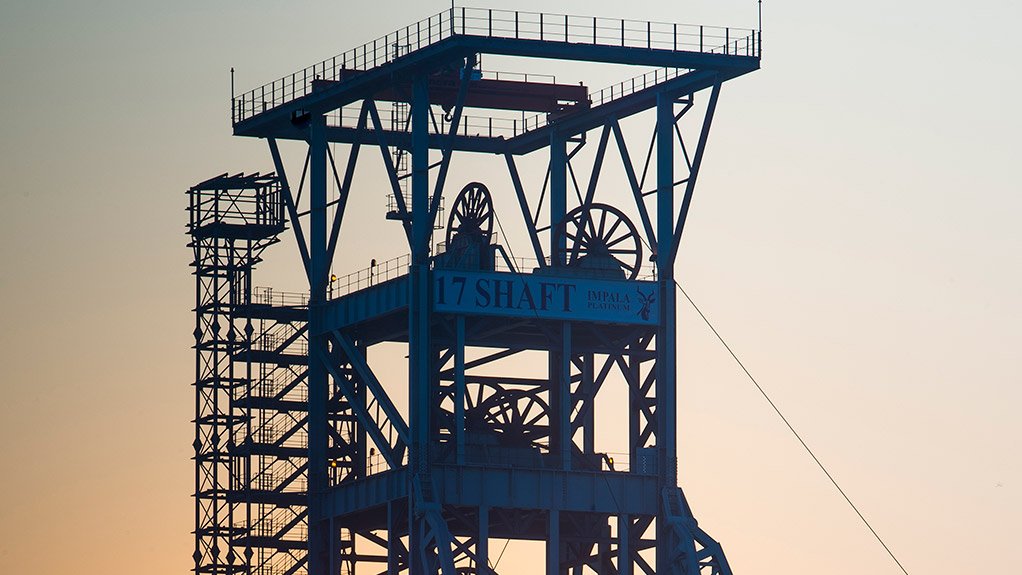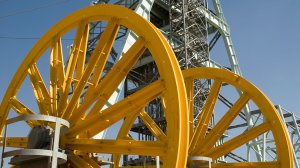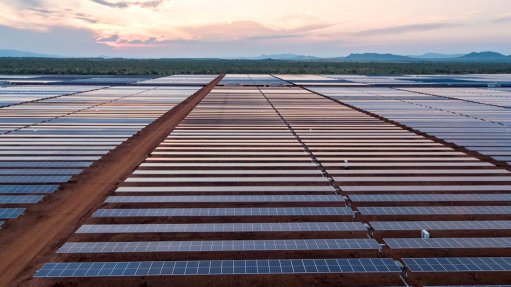Project development hindered by platinum strike



POSITIVE PROSPECTS 20 Shaft will produce about 125 000 oz/y of platinum
PRECARIOUSLY POSITIONED To date, only R4-billion of the required R12-billion has been invested to complete the development of 17 Shaft
Platinum mining major Impala Platinum’s (Implats’) No 16, 17 and 20 Shaft development projects, in the North West, have all been negatively impacted on by the protracted strike in the platinum sector, spearheaded by trade union the Association of Mineworkers and Construction Union (AMCU), says Implats growth projects and joint ventures group executive Gerhard Potgieter.
He explains that these shafts, which form part of the Impala Rustenburg platinum mine, are replacement shafts for the older infrastructure, which is experiencing declining resource availability in the Rustenburg area.
20 Shaft
Located in the uppermost area of the Rustenburg mine, 20 Shaft is ramping up production. The project started operating in 2013 and is entering year three of a five-year production ramp-up process.
Once the ramp-up is complete, the shaft will produce about 125 000 oz/y of platinum.
“The mine will continue the ramp-up process when the mineworkers return to work,” says Potgieter, adding that the development of the shaft complex came to a complete standstill because of the strike.
He notes that, when the strike started in January, Implats was using contractors to do the development work required for the ramp-up. However, owing to the volatile nature of the strike, the company decided to suspend the ramp-up development during wage negotiations.
He adds that, owing to the delay, the ramp-up process would take between nine months and a year longer to complete.
In terms of the operational aspects of the ramp-up, Potgieter says, while 20 Shaft has been commissioned, it features a different layout, compared with conventional shafts.
The shaft has only two stations with incline and decline spines accessing the reef’s horizon, as opposed to conventional shafts that usually have multiple stations.
“The shaft’s layout has lent itself to trackless mining, which is in line with what we initially intended for it. However, over time, we thought it more prudent to use conventional mining methods on the shaft’s inclines and declines,” states Potgieter.
He points out that the horizontal levels were, therefore, laid out in a conventional manner using rail tracks, hoppers and jackhammer drilling.
Potgieter adds that Implats management is conducting a feasibility study on the implementation of mechanised mining in the upper two levels of the shaft, which it aims to complete within the next 12 months.
He explains that mechanisation is being considered, as it will only need to be implemented in the last two years of the ramp-up process.
16 Shaft
This shaft is directly down dip of 1 Shaft, which is located on the southern end of the mine complex, on the Merensky reef.
Once the ramp-up phase is completed, 16 Shaft will produce 185 000 oz/y of platinum. The shaft complex was completed in June 2013 and the reef horizon has been accessed on the upper four levels, while the lower four levels are being developed to access the reef.
The ramp-up of 16 Shaft has also been suspended because of the strike, with development also being delayed by between 9 and 12 months.
Before the stoppage, the shaft was entering year two of the planned five-year ramp-up process.
The shaft features a conventional layout and eight regular stations accessing the Merensky and the upper group two reefs.
Its development leading up to the reef uses tracked mining methods in the form of locomotive rigs, which comprise an electrohydraulic drill rig built onto a standard locomotive chassis.
“While the locomotive rigs run on rails, they drill just like a standard drill rig. Therefore, conventional hand-held drilling is not required in the development process,” Potgieter explains.
The locomotive rigs require only one operator, which is safer and one of the many benefits of the rig, as the operator is positioned further away from the face, says Potgieter, who adds that a longer round can be drilled and blasted.
“Therefore, overall operational safety and efficiency levels are improved.”
Potgieter adds that the only challenge in developing 16 Shaft was that additional support structures were required, as some of the tunnels traverse the Hex river fault.
He explains that planned mining rates through the fault had to be reduced, with increased levels of long-term support, yielding capability to accommodate ground movement associated with seismic events.
He says the ramp-up on 16 Shaft, on the reef horizon, has used conventional mining crews from older Implats shafts located in Rustenburg.
Potgieter adds that when the older shafts are mined out, crews from those shafts will be relocated to 16 Shaft.
Implats also intends to conduct mechanised mining trials on the reef’s horizon, where possible.
“These trials are important, as they will help us determine the feasibility and extent to which increased mechanisation can be implemented on 16 Shaft,” he adds.
17 Shaft
Potgieter notes that 17 Shaft comprises three shaft barrels – the main, ventilation and refrigeration shafts.
“While the sinking of the ventilation and the refrigeration shafts was completed in January this year, the main shaft will reach completion in about 18 months,” he explains, adding that the bottom level, Level 28, which is the loading level of the shaft, still needs to be sunk, and all the required loading infrastructure in the bottom level needs to be mined.
“Further, 17 Shaft’s barrel needs to be equipped with steelwork.”
Meanwhile, Potgieter says, while Implats can start developing the tunnels from the completed shafts towards the reef horizon, this has not happened yet, owing to industrial action in the sector.
Nevertheless, he highlights that the sinking of the main shaft continued despite the strike, as the majority of the contractors are not AMCU members.
He adds that the development of the main shaft “has continued largely unhindered”.
“Progress on the main shaft has been satisfactory. However, starting up the development of this shaft to the reef [horizon] will depend on when the strike ends, as this will require more workers.”
Potgieter says production on the reef is likely to take place only in 2018.
He notes that Implats is flexible in terms of the way in which mining will take place in 17 Shaft.
“While the shaft features a conventional shaft layout, with eight production levels, the levels all have 4 m × 4 m twin ends, which are fully mechanised for development towards the reef’s horizon.”
Implats’ plans for mechanisation in the shaft include the use of rubber-tyre drill rigs, underground load-haul-dump loaders and full trackless mining operations, as well as rails for the shaft’s trams.
To date, there have not been any difficulties in developing 17 Shaft and, as it develops towards the reef’s horizon, the company will have to assess the geology, says Potgieter.
The company only expects development on the reef horizon to take place in January 2015 – at the earliest.
Project Disposal?
The No 20 and 16 shafts are entering the ramp-up phase and each one costs about R6.8-billion to develop, of which about R1-billion in capital expenditure (capex) per shaft still needs to be invested.
“The cash has been raised and accounted for from the company’s cash flow,” notes Potgieter, adding that Implats cannot stop development of these projects at this late stage.
He further notes that, prior to the shut down of these shafts because of the platinum strike, they were jointly producing about 5 000 oz of platinum on a monthly basis.
Potgieter emphasises that Implats will aim, therefore, to ramp up the shafts as quickly as possible to get the shafts to full production.
These shafts are urgently required, as they need to replace the existing shafts that have become unprofitable.
Potgieter says R12-billion needs to be spent on capex for 17 Shaft; R4-billion has been spent on the project to date, with the remaining R8-billion yet to be committed.
“We will have to assess whether it is viable to complete this project in the current environment,” Potgieter concludes.
Comments
Press Office
Announcements
What's On
Subscribe to improve your user experience...
Option 1 (equivalent of R125 a month):
Receive a weekly copy of Creamer Media's Engineering News & Mining Weekly magazine
(print copy for those in South Africa and e-magazine for those outside of South Africa)
Receive daily email newsletters
Access to full search results
Access archive of magazine back copies
Access to Projects in Progress
Access to ONE Research Report of your choice in PDF format
Option 2 (equivalent of R375 a month):
All benefits from Option 1
PLUS
Access to Creamer Media's Research Channel Africa for ALL Research Reports, in PDF format, on various industrial and mining sectors
including Electricity; Water; Energy Transition; Hydrogen; Roads, Rail and Ports; Coal; Gold; Platinum; Battery Metals; etc.
Already a subscriber?
Forgotten your password?
Receive weekly copy of Creamer Media's Engineering News & Mining Weekly magazine (print copy for those in South Africa and e-magazine for those outside of South Africa)
➕
Recieve daily email newsletters
➕
Access to full search results
➕
Access archive of magazine back copies
➕
Access to Projects in Progress
➕
Access to ONE Research Report of your choice in PDF format
RESEARCH CHANNEL AFRICA
R4500 (equivalent of R375 a month)
SUBSCRIBEAll benefits from Option 1
➕
Access to Creamer Media's Research Channel Africa for ALL Research Reports on various industrial and mining sectors, in PDF format, including on:
Electricity
➕
Water
➕
Energy Transition
➕
Hydrogen
➕
Roads, Rail and Ports
➕
Coal
➕
Gold
➕
Platinum
➕
Battery Metals
➕
etc.
Receive all benefits from Option 1 or Option 2 delivered to numerous people at your company
➕
Multiple User names and Passwords for simultaneous log-ins
➕
Intranet integration access to all in your organisation




















